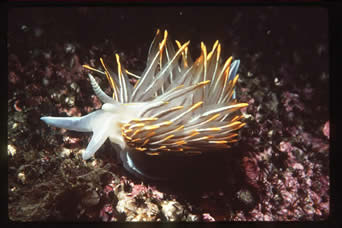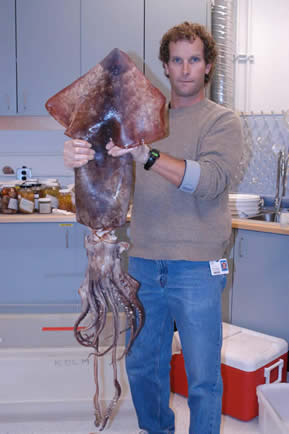

MOLLUSCS OF BRITISH COLUMBIA

Nudibranch or Sea Slug, photo by James A. Cosgrove
Phylum Mollusca: An Introduction
by
Visit our atlas pages for the Chitons, Freshwater Mussels, Freshwater Snails and Slugs, marine bivalves (seashells), Nudibranchs (sea slugs), Octopuses and Squids.
Malacology: The branch of zoology that deals with the mollusk,
the animal within the shell.
The phylum Mollusca is one of the largest and most diverse of the animal groups. It contains more than 35,000 extinct and 130,000 living species in what are currently recognized as 7 unequal Classes.
The Classes are:

Royal BC Museum Natural History Section Manager Kelly Sendell
holding a Humboldt Squid (read more about the Humboldt Squid here)
Molluscs are a very successful group and occupy most of the world’s habitats being marine, freshwater and terrestrial. Some Classes are exclusively marine (Aplacophora, Monoplacophora, Polyplacophora, Scaphopoda and Cephalopoda). Class Bivalvia has both freshwater and marine species and the Class Gastropoda has freshwater, marine and terrestrial species.
Molluscs, in general, are unsegmented, have a coelom (body cavity containing organs), a shell of calcium carbonate, a mantle that produces the shell, a single muscular foot, gills, and a file-like tongue called a radula. There are, however, many variations within the phylum where shells and other features are modified, reduced or entirely absent.
Molluscs are represented by a huge variety of body forms. Everything from the small, shell-less, wormlike Aplacophorans weighing only a few grams to the largest known invertebrate, the colossal squid (Class Cephalopoda), weighing several hundred kilograms.
Members of the Phylum Mollusca also show great diversity in the foods they eat. Most Aplacophorans are detritus feeders, eating the mud surrounding them and digesting the organic components. Most monoplacophorans, polyplacophorans, bivalves and scaphopods are herbivores and use their radulas to scrape algae off rocks or have evolved filtering mechanisms to take algae out of the water. There are, however, a few omnivores and carnivores in those classes. The gastropods show the most diversity in the types of food gathered as would be expected given the diversity of habitats they occupy. Many gastropods are carnivorous and some, such as cone snails, possess venom that can be lethal to humans. The cephalopods are all carnivores and many of them also possess venom. Most are not dangerous to humans but some, such as the group of Blue Ringed octopuses, have been known to kill while protecting themselves.
EXTERNAL LINKS
Seashells of British Columbia (Peter Egerton)
Terrestrial Gastropods of the Columbia Basin (Royal BC Museum--Living Landscapes)
COSEWIC Status Report on Oregon ForestSnail
Key to Slugs of BC (Botanical Electronic News #320)
KEY REFERENCES
Berry, S.S. 1922. Land snails of the Canadian Rockies. Victoria Memorial Museum, Bulletin 36: 19 pp.
Binney, W.G., and T. Bland. 1869. Land and fresh water shells of North America. Part 1, Pulmonata Geophila. Smithsonian Miscellaneous Collections 194: xii + 316 pp.
Branson, B.A. 1977. Freshwater and terrestrial Mollusca of the Olympic Peninsula, Washington. The Veliger 19: 310-330.
Cameron, R.A.D. 1986. Environment and diversities of forest snail fauna from coastal British Columbia. Malacologia 27: 341-355.
Chichester, L.F., and L.L. Getz. 1968. Terrestrial slugs. The Biologist 50: 148-166.
Dall, W.H. 1905. Land and freshwater mollusks of Alaska and adjoining regions. Harriman Alaska Expedition 13: i-xii, 1-171, pls. i-ii. Doubleday Page & Company, New York.
Foryth, R.G. In press. Distribution of nine new or little known exotic land snails in British Columbia. The Canadian Field-Naturalist.
Habe, T. 1964. Shells of the Western Pacific in Color, 2. Hoikusha Publishing, Osaka. 233 pp., 66 pls.
Hanna, G D. 1966. Introduced mollusks of western North America. Occasional Papers of the California Academy of Sciences 48: 108 pp., 4 pls.
Hubricht, L.H. 1985. The distribution of the native land mollusks of the eastern United States. Fieldiana Zoology (n.s.)24: vii + 191 pp.
Keen, A.M. and E. Coan. 1974. Marine Molluscan Genera of Western North America: An Illustrated Key. 2nd edition. Stanford University Press, Stanford, Calif. 208 pp.
La Rocque, A. 1953. Catalogue of the Recent Mollusca of Canada. National Museum of Canada, Bulletin 129: ix + 406 pp.
Pilsbry, H.A. 1939-1948. Land Mollusca of North America (north of Mexico). 1939: The Academy of Natural Sciences of Philadelphia, Monograph 3, 1(1): i-xvii, 1-573, i-ix. 1940: ibid., 1(2): 575-994, i-ix. 1946: ibid., 2(1): i-iv, 1-520, i-ix, frontispiece. 1948: ibid., 2(2): i-xlvii, 521-1113.
Rollo, C.D. and W.G. Wellington. 1975. Terrestrial slugs in the vicinity of Vancouver, British Columbia. The Nautilus 89: 104-115.
Turgeon, D.D, A.E. Bogan, E.V. Coan, W.K. Emerson, W.G. Lyons, W.L. Pratt, C.F.E. Roper, A. Scheltema, F.G. Thompson, and J.D.Williams. 1988. Common and scientific names of aquatic invertebrates from the United States and Canada: Mollusks. American Fisheries Society Special Publication 16: viii + 277 pp., 12 pls.
Vanatta, E.G. 1906. British Columbia shells. The Nautilus 20: 95.
Please cite these pages as:
Author, date, page title. In: Klinkenberg, Brian. (Editor) 2021. E-Fauna BC: Electronic Atlas of the Fauna of British Columbia [www.efauna.bc.ca]. Lab for Advanced Spatial Analysis, Department of Geography, University of British Columbia, Vancouver. [Date Accessed]
© Copyright 2021 E-Fauna BC.